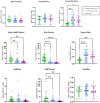Altered O-Glycans in stimulated whole saliva from patients with primary Sjögren's syndrome and non-pSS sicca
- PMID: 39592783
- PMCID: PMC11599585
- DOI: 10.1038/s41598-024-79473-1
Altered O-Glycans in stimulated whole saliva from patients with primary Sjögren's syndrome and non-pSS sicca
Abstract
To investigate if salivary O-linked glycans are altered in primary Sjögren's syndrome (pSS), and thus contributing to explain symptoms of oral dryness, and an impaired oral mucosal barrier function leading to changes in microbial metabolism and colonization by both pathogenic and commensal microorganisms and increased prevalence of oral diseases. O-linked oligosaccharides from stimulated whole saliva (SWS) samples from 24 patients with pSS, 38 patients with non-pSS sicca, and 23 healthy controls were analyzed using liquid chromatography mass spectrometer (LC-MS). Non-fractionated reduced and alkylated saliva was dot-blotted to PVDF-membrane and O-linked oligosaccharides were released using reductive beta-elimination. The 50 most abundant glycans were identified and their intensity compared for each sample, reflecting the relative abundance of individual monosaccharide residues. Comparison of the compositions of O-glycans in SWS samples revealed higher relative levels of sialic acid (NeuAc) and lower levels of neutral amino-monosaccharides (HexNAc) in pSS and non-pSS sicca patients than in the healthy controls. MS2 fragmentation analysis of salivary O-glycans suggests that altered sulfation, fucosylation, sialylation and distribution of core types may all contribute to the observed alteration, directly or indirectly. Additionally, the short disaccharide sialyl-Tn was most abundant in the saliva samples from patients with pSS. Our findings indicate that the salivary mucin-type O-glycan profile is altered in pSS, reflecting a dysfunction of the post-translational modification of salivary mucins leading to rheological changes of saliva, oral dryness symptoms, and impaired oral mucosal barrier function. The pathophysiological significance of the aberrant O-glycosylation needs further elucidation.
Keywords: Hyposalivation; O-glycans; Primary Sjögren’s syndrome; Sialyl-Tn.
© 2024. The Author(s).
Conflict of interest statement
Declarations. Competing interests: The authors declare no competing interests. Ethics approval and patient consent: The study was performed following the Declaration of Helsinki and approved by the Ethical Committees for the Region of Copenhagen, Denmark (H-18042385). Written informed consent was obtained from all participants.
Figures



Similar articles
-
Reduced Mucin-7 (Muc7) Sialylation and Altered Saliva Rheology in Sjögren's Syndrome Associated Oral Dryness.Mol Cell Proteomics. 2016 Mar;15(3):1048-59. doi: 10.1074/mcp.M115.052993. Epub 2015 Dec 2. Mol Cell Proteomics. 2016. PMID: 26631508 Free PMC article.
-
Proteomic and histopathological characterisation of sicca subjects and primary Sjögren's syndrome patients reveals promising tear, saliva and extracellular vesicle disease biomarkers.Arthritis Res Ther. 2019 Jul 31;21(1):181. doi: 10.1186/s13075-019-1961-4. Arthritis Res Ther. 2019. PMID: 31366407 Free PMC article.
-
Microbial signatures in oral sites of patients with primary Sjögren's syndrome: Association with salivary gland hypofunction.J Microbiol. 2025 Jun;63(6):e2501030. doi: 10.71150/jm.2501030. Epub 2025 Jun 30. J Microbiol. 2025. PMID: 40598993
-
The Proteomics of Saliva in Sjögren's Syndrome.Rheum Dis Clin North Am. 2016 Aug;42(3):449-56. doi: 10.1016/j.rdc.2016.03.004. Epub 2016 Jun 21. Rheum Dis Clin North Am. 2016. PMID: 27431347 Free PMC article. Review.
-
Chemosensory dysfunction in primary Sjögren's syndrome: a topical review.Clin Rheumatol. 2023 Jan;42(1):1-14. doi: 10.1007/s10067-022-06359-w. Epub 2022 Sep 5. Clin Rheumatol. 2023. PMID: 36063255 Free PMC article. Review.
References
-
- Fox, R. I. Sjögren’s syndrome. Lancet. 366, 321–331 (2005). - PubMed
-
- Longhino, S. et al. Sjögren’s syndrome: one year in review 2023. Clin. Exp. Rheumatol.10.55563/clinexprheumatol/255qsx (2023). - PubMed
-
- Nocturne, G. & Mariette, X. Advances in understanding the pathogenesis of primary Sjögren’s syndrome. Nat. Rev. Rheumatol.9, 544–556 (2013). - PubMed
-
- Chaudhury, N. M. A., Shirlaw, P., Pramanik, R., Carpenter, G. H. & Proctor, G. B. Changes in saliva rheological properties and mucin glycosylation in dry mouth. J. Dent. Res.94, 1660–1667 (2015). - PubMed
-
- Pedersen, A. M. L., Sørensen, C. E., Proctor, G. B., Carpenter, G. H. & Ekström, J. Salivary secretion in health and disease. J. Oral Rehabil. 45, 730–746 (2018). - PubMed
MeSH terms
Substances
LinkOut - more resources
Full Text Sources
Medical

